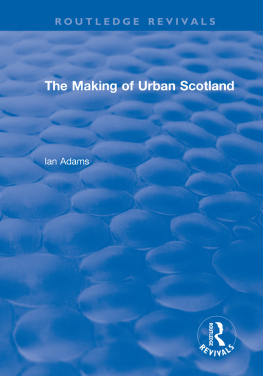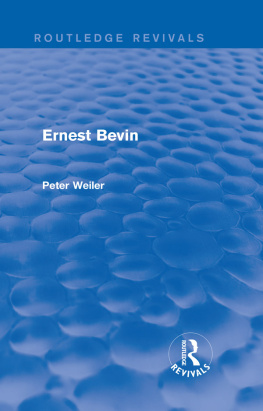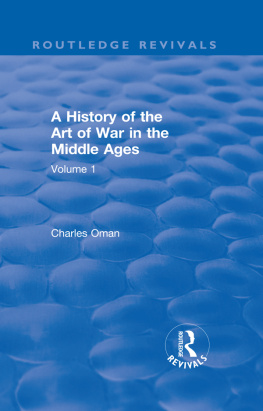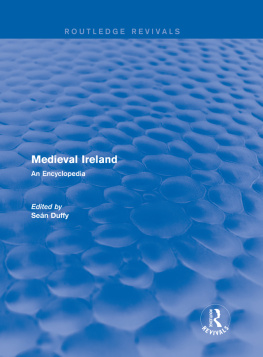Routledge Revivals
The Making of Urban Scotland
Originally published in 1978, The Making of Urban Scotland traces the evolution of towns from their prehistoric origins to the present day. Most of the material is based on research in Scotlands archives, housed in the Scottish Record Office. Special emphasis is placed on the causes of economic change and its repercussions upon Scottish town life. The urban stresses of the nineteenth century are analysed in detail, as well as the subsequent emergence of Scotland as Western Europes pre-eminent council house society. The unique character of Scotlands housing occupies two chapters and for the first time the whole panoply of the statuary origins of the council house landscape is exposed.
The Making of Urban Scotland
By Ian H. Adams
First published in 1978
by Croom Helm Ltd.
This edition first published in 2018 by Routledge
2 Park Square, Milton Park, Abingdon, Oxon, OX14 4RN
and by Routledge
711 Third Avenue, New York, NY 10017
Routledge is an imprint of the Taylor & Francis Group, an informa business
1978 Ian H. Adams
All rights reserved. No part of this book may be reprinted or reproduced or utilised in any form or by any electronic, mechanical, or other means, now known or hereafter invented, including photocopying and recording, or in any information storage or retrieval system, without permission in writing from the publishers.
Publisher's Note
The publisher has gone to great lengths to ensure the quality of this reprint but points out that some imperfections in the original copies may be apparent.
Disclaimer
The publisher has made every effort to trace copyright holders and welcomes correspondence from those they have been unable to contact.
A Library of Congress record exists under LCCN: 78317868
ISBN 13: 978-1-138-49111-3 (hbk)
ISBN 13: 978-1-351-03378-7 (ebk)
THE MAKING OF URBAN SCOTLAND
CROOM HELM HISTORICAL GEOGRAPHY SERIES
Edited by R.A. Butlin
THE DEVELOPMENT OF THE IRISH TOWN
Edited by R.A. Butlin
THE MAKING OF URBAN SCOTLAND
I.H. Adams
THE MAKING OF URBAN SCOTLAND
Ian H. Adams
1978 Ian H. Adams
Croom Helm Ltd, 2-10 St John's Road, London SW11
British Library Cataloguing in Publication Data
Adams, Ian Hugh
The making of urban Scotland.
1. Cities and towns - Scotland - History
I. Title
941.1'00973'2 HT133
ISBN 0-85664-518-4
McGill-Queen's University Press
1020 Pine Avenue West, Montreal H3A 1A2
ISBN 0-7735-0329-3
Legal deposit 2nd quarter 1978
Bibliotheque Nationale du Quebec
'... a city is more than a place in space, it is a drama in time. Though the claim of geography be fundamental, our interest in the history of the city is supremely greater...
Patrick Geddes 1905
To Judy and Christopher
This book could not have been written without help from several institutions and many individuals. The Keeper of the Records of Scotland, and his staff in the Scottish Record Office, have my heartfelt appreciation for their constant support, as do Professors Wreford Watson and Terry Coppock for the encouragement in the long task of unearthing from the archives the hidden story of Scotland's historical geography.
I have had the pleasure of discussing the work with many individuals, including George Barbour, Sheila Coppock, . Y. Dodd, Colin Johnston, Charles Somerville, Geoffrey Stell. Liz Thorns and Ian Wyhte. I thank them all for giving me their time and knowledge.
Above all others I must thank Meredyth Somerville and Mary Young for giving unstinting labour and steadfast encouragement in the production of this book. Meredyth has again turned her bibliographic skills to a major task and provided the stimulus to bring the work to fruition, while Mary's cheerfulness lightened many a day of correcting rough drafts.
The illustrations from the Scottish Record Office are published with the approval of the Keeper of the Records of Scotland. I would also like to thank the owners of plans also in the custody of the Scottish Record Office: the Marquis of Zetland, the Earl of Eglinton and Winton and Messers. Shepherd and Wedderburn, WS, Edinburgh. Other items are published by permission of the Controller of HM Stationery Office. G. B. Arrington's photographs are but a few of a splendid portfolio taken by this American town planner. The numerous diagrams were so skilfully drawn by Ray Harris and his team of cartographers in the Department of Geography, University of Edinburgh. Permission for photographs was kindly given by: Aero-films Ltd; John Bartholomew (dust jacket); John Dewar Studio; East Kilbride Development Corporation; New Lanark Conservation Trust; The Scotsman; Scottish Record Office; C. Somerville.
Lastly to my wife - my thanks for her patience.
Ian Adams, 1977

Edinburgh Corporation accepts no responsibility... (Photo: G.B. Arrington.)
On a grey November evening as a fresher at Edinburgh, tired by the grind at standard texts in the stuffy and rather decrepit vastness of the Upper Library in the Old Quad, I idly lifted a volume entitled The Making of the English Landscape , to have revealed from the pen of W.G. Hoskins a language of landscape. The closing bell came all too soon down stone stairs, across the dimly lit quad and out on to the deserted Bridges for me landscape had taken on a new meaning.
Two of the themes of Hoskins' great work are taken up in a Scottish context. First, that the landscape is a living document on which past ages have made a virtually indelible impression. Our life today and tomorrow cannot be isolated from the past; rather we have to carry both the material and cultural baggage of the past into the future. Secondly, I have tried, like Hoskins, to redress prevalent distortions: in this case the historical preoccupation with Mary Queen of Scots and Bonnie Prince Charlie, and the geographical preoccupation with the Highlands, The story of where and how ordinary people lived has been largely ignored. As for the Highlands, it is hard to find a rational explanation for the continued emphasis on this marginal region. Just over four-fifths of Scotland's population live in the Lowlands. Within that area, more people live in Airdrie than in the whole of the Highlands! If Scotland really wants to establish her social priorities, she should look no further than the living conditions of her city dwellers, particularly in the West Central Belt. The Scots are an urban people, whose rural links have been severed for almost two hundred years. In the rapid progress of agricultural revolution a large part of the population was released from rural existence. Freed from their fermtouns, Scots migrated to towns and cities to man the factories springing up in the industrial revolution and, indeed, it was the very speed and success of this transformation that led to the unhappy problems of Scottish city life. Yet we need no longer think these problems are insoluble: technical and administrative solutions exist which, if properly applied, could transform the urban situation. Some have had a certain amount of success the new towns, overspill agreements and the swinging back of the centre of economic activity to the east coast but others, such as the huge housing estates and the mania for high-rise flats, have not been successful and have produced new problems. At a time when we are becoming more conscious of the blunders of the past 150 years as well as of the possibilities for the future it behoves us to understand how urban Scotland came into being.












